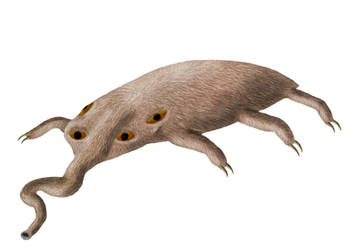ShopDreamUp AI ArtDreamUp
Deviation Actions
Description
Another day, another hybrid to give a purpose in this multiverse, this time, this guy img.7te.org/images/570x363/ele… a hippopotamus with a basking shark head, with some extra features that could imagine, the history behind this animal is interesting.
The Fluvial gigamounth (Titanognatus potamus), is a rare semi-aquatic tetrapod, inhabitant of the Amazon rivers, being one of the largest species of its lineage with a lenght of 3 m and a weight of 500 kg. Is primarily a filter feeder that feed in the bottom of the rivers, mostly the silt rich in nutrients, small invertebrates and some school of small fishes.
Its ancestors date back to the middle and late of a much more humid Paleozoic, the carboniferous in its timeline never ended as it did, causing much of the next period, the permian, to remain completely humid and maintaining much of the terrestrial groups of tetrapods in an amphibious state, although also amniotes evolved, however, did not expand as they would have done in our timeline.
In addition to the fact that basalt eruptions never occurred during the end of the permian, this allowed to the diversification of these new clades of tetrapods, evolving into new clades so diverse as the amniotes of our timeline, some preserving their amphibian lifecycle. Unfortunately, the period of stability ended with the separation of the supercontinent Pangea due to the opening of the Atlantic Ocean, causing a climatic change on a large scale and causing the mass extinction of the late triasic.
During the jurassic and the cretaceous some of the true amniotes with other groups of tetrapods take over after, being the dominant groups, leaving the few amphibian groups relegated to smaller niches. After the K/Pg event, most of these dominant amniotes and paramniotes lineages perished, which allowed some amphibian clades located in continents such as South America, Australia and Africa to evolve and take up much of the ecological niches available during the Cenozoic. These amphibians arent like our amhibians, some have metabolisms almost similar to those of amniotes, are quite active, and some possess even a semi-erect posture that allows them greater mobility on land. The Fluvial gigamounth belong to these forms, evolving a posture much more erect, and developing a rather primitive characteristic, gills, which allows it to keep under water for a very long time.
The Fluvial gigamounth (Titanognatus potamus), is a rare semi-aquatic tetrapod, inhabitant of the Amazon rivers, being one of the largest species of its lineage with a lenght of 3 m and a weight of 500 kg. Is primarily a filter feeder that feed in the bottom of the rivers, mostly the silt rich in nutrients, small invertebrates and some school of small fishes.
Its ancestors date back to the middle and late of a much more humid Paleozoic, the carboniferous in its timeline never ended as it did, causing much of the next period, the permian, to remain completely humid and maintaining much of the terrestrial groups of tetrapods in an amphibious state, although also amniotes evolved, however, did not expand as they would have done in our timeline.
In addition to the fact that basalt eruptions never occurred during the end of the permian, this allowed to the diversification of these new clades of tetrapods, evolving into new clades so diverse as the amniotes of our timeline, some preserving their amphibian lifecycle. Unfortunately, the period of stability ended with the separation of the supercontinent Pangea due to the opening of the Atlantic Ocean, causing a climatic change on a large scale and causing the mass extinction of the late triasic.
During the jurassic and the cretaceous some of the true amniotes with other groups of tetrapods take over after, being the dominant groups, leaving the few amphibian groups relegated to smaller niches. After the K/Pg event, most of these dominant amniotes and paramniotes lineages perished, which allowed some amphibian clades located in continents such as South America, Australia and Africa to evolve and take up much of the ecological niches available during the Cenozoic. These amphibians arent like our amhibians, some have metabolisms almost similar to those of amniotes, are quite active, and some possess even a semi-erect posture that allows them greater mobility on land. The Fluvial gigamounth belong to these forms, evolving a posture much more erect, and developing a rather primitive characteristic, gills, which allows it to keep under water for a very long time.
Image size
1603x770px 363.92 KB
© 2017 - 2024 Dragonthunders
Comments28
Join the community to add your comment. Already a deviant? Log In
Awesome design

































